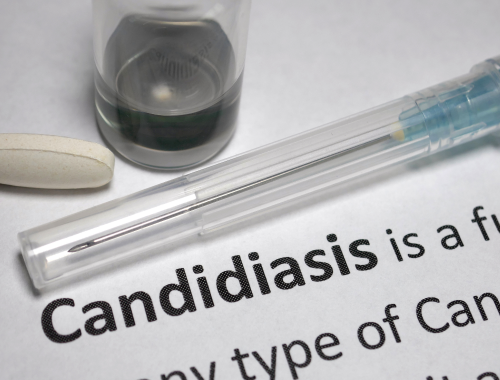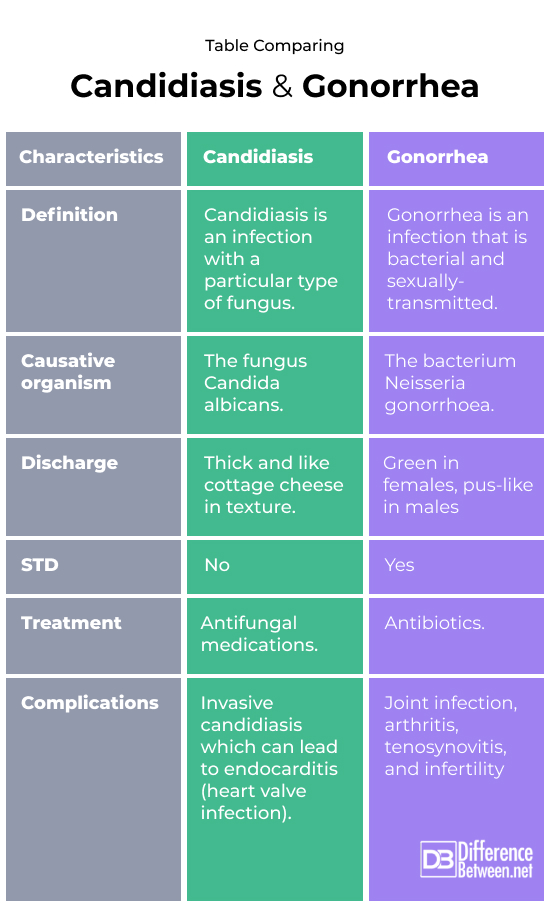Difference Between Candidiasis and Gonorrhea
Candidiasis is a fungal infection that affects the skin or mucous membranes. Gonorrhea is a sexually-transmitted bacterial infection that affects the reproductive organs.

What is Candidiasis?
Definition:
Candidiasis is an infection caused by a fungus, which affects the skin, mucous membranes of the mouth and vagina, and throat and stomach.
Causes and prevalence:
Candidiasis is a yeast infection caused by an overgrowth of the fungal organism, Candida albicans. The fungus is a naturally occurring organism in the human body but sometimes there is a microbial imbalance in which the Candida overgrows.The infection is most common in infants and the elderly but affect about ¾ of all females at some stage in their lives.
Symptoms:
The signs of candidiasis include the presence of a white substance on the affected area. Women may have a cottage cheese type of discharge from the vagina. If in the mouth, candida causes oral thrush. The mouth will often feel sore, cracks may develop at the corners of the mouth, and the tongue will have a white coating.
Complications:
Candidiasis is not normally serious except in small infants or people with a compromised immune system. In these situations, there is a risk that the fungus may spread and infect other organs and parts of the body, including the heart valves. If the heart valves are infected it causes endocarditis, which can be dangerous.
Diagnosis:
Diagnosis can be done by taking a sample of the affected tissue and culturing it. The sample may also be examined under a microscope for signs of fungi.
Treatment:
For most cases of candidiasis, the antifungal fluconazole is used. For more serious infections, intravenous antifungals, such as fluconazole, amphotericin B, and caspofungin may be administered. Antifungal creams can be used for infections of the vaginal area.

What is Gonorrhea?
Definition:
Gonorrhea is one of the sexually transmitted diseases (STDs), which is due to infection with a gram-negative bacterium.
Causes and prevalence:
Neisseria gonorrhoea is the cause of this condition, which is sexually transmitted from person to person. The infection is common with over 1 million cases a year in the United States alone.
Symptoms:
In men, the signs of gonorrhea include a discharge that looks like pus that comes from the penis, pain and swelling in the testes. Women with gonorrhea have a green discharge from the vagina, pelvic pain, bleeding between periods and pain when urinating. Men also experience pain when urinating when they have gonorrhea. The bacteria cause inflammation of the urethra in men and of the cervix in women.
Complications:
Gonorrhea can spread to the joints in severe cases, causing infection. It also can result in infertility in men and women. Babies born to mothers with the disease are at risk of having their eyes affected adversely. Having gonorrhea also increases the risk of men and women catching HIV.
Diagnosis:
Diagnosis of gonorrhea is achieved by using a molecular biology test known as nucleic acid amplification testing. Urine, blood, and other body fluids can be tested for the bacterium.
Treatment:
Antibiotics such as ceftriaxone are used to kill the bacteria that causes gonorrhea. The CDC recommends that this be given as an injection into the muscles.
Difference between Candidiasis and Gonorrhea?
Definition
Candidiasis is an infection with a particular type of fungus. Gonorrhea is an infection that is bacterial and sexually-transmitted.
Causative organism
Infection with the fungus Candida albicans causes candidiasis. Infection with the bacterium Neisseria gonorrhoea causes gonorrhea.
Discharge
With candidiasis there can be a discharge that is thick and like cottage cheese. With gonorrhea the discharge is green in females and like pus in males.
STD
Candidiasis is not an STD. Gonorrhea is an STD.
Treatment
Antifungal medications such as ketoconazole or amphotericin B are used for treating people who have candidiasis. Antibiotics, usually ceftriaxone, is given by an injection in a muscle; this is the recommended treatment for people with gonorrhea.
Complications
In the case of candidiasis, the infection can become invasive, which can then result in endocarditis (heart valve infection). In the case of gonorrhea, the infection can cause infertility in both women and men, and the infection can also spread to the joints.
Table comparing Candidiasis and Gonorrhea

Summary of Candidiasis Vs. Gonorrhea
- Candidiasis and gonorrhea can both affect the urogenital area.
- Candidiasis is not an STD while gonorrhea is.
- You can treat candidiasis with antifungals but you need to use antibiotics to treat gonorrhea.
FAQ
Can gonorrhea cause candidiasis?
No, gonorrhea does not cause candidiasis.
What is the difference between Candida and chlamydia?
Candida is the yeast that can cause candidiasis. Chlamydia is a bacterium that in humans, is sexually transmitted.
What type of STD is candidiasis?
Candidiasis is not classified as an STD.
What infections can be mistaken for gonorrhea?
Chlamydia has some of the same symptoms as gonorrhea, such as burning when urinating.
Can gonorrhea be confused with a yeast infection?
For both conditions, there is a discharge. However, the gonorrhea discharge does not look like cottage cheese and is often green or pus-like.
What are three signs of gonorrhea?
There are three signs to look for if you think you have gonorrhea. First is discharge which may be green, yellow, or pus-like. The second sign is needing to urinate often and burning during urination. The third sign is pain in the lower part of the abdomen (in women) or in the testes and penis (in men).
- Difference Between Rumination and Regurgitation - June 13, 2024
- Difference Between Pyelectasis and Hydronephrosis - June 4, 2024
- Difference Between Cellulitis and Erysipelas - June 1, 2024
Search DifferenceBetween.net :
Leave a Response
References :
[0]Barantsevich, Natalia, and Elena Barantsevich. "Diagnosis and treatment of invasive candidiasis." Antibiotics 11.6 (2022): 718.
[1]Morgan, Mackenzie K., and Catherine F. Decker. "Gonorrhea." Disease-a-Month 62.8 (2016): 260-268.
[2]Revankar, Sanjay G. “Candidiasis (Invasive)(Candidosis; Moniliasis)”. Merckmanuals. Merck & Co., 2020, https://www.msdmanuals.com/professional/infectious-diseases/fungi/candidiasis-invasive
[3]Image credit: https://www.canva.com/photos/MAEAIiFb-5U-on-the-table-are-pills-a-thermometer-leaves-and-a-notebook-with-the-inscription-gonorrhea/
[4]Image credit: https://www.canva.com/photos/MAEFlYTFSWo-candidiasis/
